(written from a Production point of view)

Constellation-class USS Stargazer
The Constellation-class was created before Star Trek: The Next Generation actually began shooting, though its designation was only established later on. The need arose in pre-production from the desire to have Captain Picard's ready room dressed with some set pieces, among others, a desktop model of his previous command as mentioned in the The Writer's Bible for the show.
Intended originally to be featured as a desktop model only, the eventually realized model, at the time only endowed with the registry "NCC-7100", spawned a full-fledged studio model as well later on in the first season of the new series, now carrying the designation "USS Stargazer (NCC-2893)", Picard's former command. Discounting the "hero"-ship of the new series, the USS Enterprise-D, it was the first new Starfleet starship design seen by audiences, since Star Trek III: The Search for Spock.
Design
As for the desktop model Rick Sternbach recalled, "Andy Probert and I began fleshing out the Stargazer during the pre-production phase of Star Trek: The Next Generation, based on a mention of Captain Picard's previous command in the TNG writer's bible. We likely had some words with set decorator John Dwyer about a model of the ship for Picard's ready room, along with the collaborative painting of the Galaxy class Enterprise to fill up a big empty spot over the sofa. Probert and I discussed the general configuration of the Stargazer, did a number of quick pencil and marker doodles of the major assemblies, and settled on using four nacelles to suggest that the Stargazer was a fast science vessel. Kitbashing the display model could have made use of the plastic parts from a couple of Original Series Enterprise hobby kits, but the historical era could have a bit too old. I don't believe a kit of the Excelsior-class, eventually to become the USS Enterprise-B, had been released by that time, so we got to work playing with pieces from two NCC-1701 Refit kits." [1](X)
Desktop model

¾ aft view of the model
Picard's display, or desktop model was co-designed by Probert and Sternbach, the latter also being the one who constructed the model. Probert noted on the design, "Now, Gene dictated that there are no three-engine starships and no single-engine starships. When I was first designing the new Enterprise he said, "The Federation ship's engines always are co-dependent". It is the same as to say they always worked in twos. So that's why when Sternbach and I came up with the Stargazer, it had two sets of twos. And then I started thinking that, back in World War II, all the nations that had fighter aircraft and airplanes did the same thing: they took off, they flew, they landed, they maneuvered. They usually had one engine, two wings, two tailwings – so they all had the same components, but they all looked different. There was a national design bias to each aircraft, but technically they all did the same thing. So my thinking was in Star Trek – since the Enterprise used to have two engines – I came up with the idea that the engines had to reach out to each other in order to work co-dependently. In other words, there would be no obstructions between the engines to disrupt the energy fields or connecting forces between them." [2](X) The model was mostly kit-bashed from commercially available refit-Enterprise AMT/Ertl model kits (No. 6675) augmented with custom made parts from styrene sheets for the enlarged saucer section. According to Sternbach, the desktop model was further detailed with several anime kits from the Super Dimension Fortress Macross, Super Dimension Century Orguss, Gundam, and Crusher Joe. The largest of these model kit details were the wings and wing box assemblies of a VF-1 Valkyrie model kit from Macross. The desktop model was finished in a dark desert yellow with blue accents and could subsequently been seen as a desktop model in Picard's ready room in numerous episodes of the show. A registry number "NCC-7100" was applied to the model, but no name, possibly indicating a generic model of the class. [3](X)
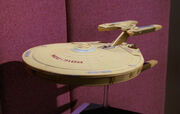
¾ front view of the model
The model first appeared in "Encounter at Farpoint" but was absent during the first official appearance of a Constellation-class ship in "The Battle", replaced with a model of a modified refit-Constitution-class ship, as the USS Stargazer was originally intended to be a member of that class. Probert and Sternbach later persuaded the producers to build a new, full-fledged filming miniature for the Stargazer and the desktop model remained absent for additional episodes as it was needed at Gregory Jein, Inc. for reference during the construction of the motion-control model. This later four-foot (120 cm) shooting model used parts tooled from scratch to replicate the model kit parts used in the desktop model, with the exception of the VF-1 Valkyrie parts, since equivalent parts were found from a larger-scale kit.
The yellow model's registry was accomplished by simply rearranging the "NCC-1701" registry decals that came with the refit-Enterprise model kits (also explaining why the desktop model came without a name), much like the namesake Constitution-class USS Constellation's one, "NCC-1017", had been almost exactly two decades earlier. (Star Trek: The Official Starships Collection, issue 19, p. 13) From an in-universe POV, the registry numbers intended for use on the Constellation-type vessels might have been that high, as the number NCC-2893 had already been used on the ship's plaque from the script, when the ship was still intended to be a refitted Constitution at the time. Rick Sternbach's perspective on the model, from the Drex Files(X), "It's like Camelot, it's only a model. Pretend the NCC-7100 isn't there, and it's exactly like a corporate desk model of, say, an F-22 with generic markings and no specific tail number. Yes, the model represents the USS Stargazer, and if we knew back in early 1987 what the actual reg number would turn out to be, we would have used that. Just keep saying: 'There is no 7100... there is no 7100'."
Portions of the Star Trek: The Next Generation Technical Manual, co-written by the designers/builders who worked on the model itself, include descriptions of starship prototype phases when new ships are painted with a yellow overcoat to reveal warp field stresses. Sternbach, who built the model, later commented on the color, "The yellow color harmonized with the overall scheme for the ready room, and could be rationalized in a pinch as being a specialized hull coating used in initial warp field tests. Yeah, that's the ticket." [4](X) Some fans have interpreted that Picard kept the model because the starship NCC-7100's test flight was important to him in some way. The real world reason for the yellow color was incidentally more prosaic; it was chosen because it nicely contrasted with with overall the red and blue colorscheme of the ready room set. (Star Trek: The Official Starships Collection, issue 19, p. 13)
This starship was still referred to as the Stargazer by some members of the writing staff, notably in the script for "Chain of Command, Part I".
Interestingly, the very first commercially available model of this class, the gaming miniature sized micro machine from Galoob (issue 66106 , 3rd edition), was in this color scheme, and although given the name and registry number of the Stargazer, the producers were probably being confused by early publicized photos.
As for the desktop model itself, it has not been sighted again after its production use.
Filming model
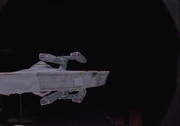
|
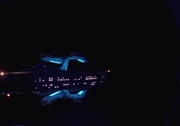
|

|
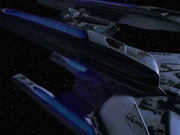
|
The producers did not make the decision to build a full scale filming, or studio model, of the Stargazer until after first-unit photography was completed, with both Wil Wheaton and LeVar Burton calling it a Constitution. The choice of the name "Constellation" was based largely on the fact that it could be dubbed over La Forge's line since the two words are so similar. (Star Trek: The Next Generation Companion, 2003, p. 41) The task of building the full scale, four-foot, model fell to Gregory Jein, using the equivalent parts from larger-scaled VF-1 Valkyrie model kits. [5] [6] The Stargazer was the first new Federation starship design seen by audiences since the introduction of the USS Enterprise-D and remained so until the introduction of the Ambassador-class in the third season's "Yesterday's Enterprise". It is also one of the very few starship designs that originally started out as a prop, but was upgraded to function as a full-fledged filming model.
After its first appearance as Picard's former command in "The Battle", the model made only three subsequent appearances in the series. In the second season episode "Elementary, Dear Data", she appeared as the USS Victory in a closing shot of the episode, filmed in such a way that relabeling was not deemed necessary, conceivably even being stock footage shot for the prior episode, which however, was not featured there. [7] A far more prominent re-appearance – with newly shot footage – occurred later on in the same season as the USS Hathaway (NCC-2593) in "Peak Performance", for which the model was relabeled by Michael Okuda's Art Department, the only time during the production life of the model. The model made one final, fleeting appearance in the season five episode "Redemption II", still carrying the Hathaway labeling. All the footage shot of the model was done at Image G.
The model was eventually labeled the USS Valkyrie (an in-joke of the production staff, as it referred to the Valkyrie parts they used in constructing the model) for tour displays such as Star Trek: The Exhibition, Star Trek World Tour, and Star Trek: The Adventure, complete with the registry NCC-2590. [8](X) Established as an older design, the model's use as a production asset was played out early on, and the studio released it very soon afterwards for public relation purposes, probably having been on tour more than any other model, the 1994 Exhibition tour being its first. The faded name USS Hathaway has been observed on this model underneath the Valkyrie decal, the only time the vessel was relabeled (later appearances being stock footage).
As of 2011, the studio model itself, having escaped the 40 Years of Star Trek: The Collection, and It's A Wrap! sale and auction's, is still in the possession of CBS Consumer Products and has been on tour as late as 2011. [9]
CGI models
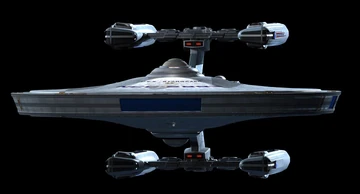
| |
| File:USS Hathaway aft (original).jpg | 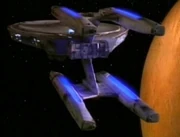
|

| |
Since the Constellation-class has already been considered an obsolete vessel in the early TNG era, no CGI model was ever constructed for live-action production purposes until 2012, and has therefore not been visually present in any of the other Star Trek series.
Still, a CGI model was eventually constructed by Doug Drexler, when he was asked to do the cover for Michael Jan Friedman's (licensed) novel Enigma in 2004. Drexler remembered on his blog(X), "Usually covers like this don't come with a lot of lead time, and the budget does not provide for building models, so I set to work converting the Directors Cut TMP CG Enterprise. Margaret Clark had spotted a cover of a novel that showed a WWII Hellcat dive bomber double exposed over the ocean blended with a map. She sparked to that and thought it was just the thing to hang the "Enigma" cover on. I grabbed a starmap that I had been admiring which Alan Kobayashi had made for Mike to hang in Captain Archer's cabin. That was the cover, and a real nice one too! Someone wrote me a note asking if I could run some Stargazer orthos. I had never made any for the blog because it was such a quickie kitbash, I figured it wouldn't hold up." Missing some of the details found on the physical models (especially on the ventral side), the CGI version found its way on other licensed products as well, such as the Ships of the Line books and Star Trek: Ships of the Line (2005) calendar. [10](X)
In 2012 a new CGI model was constructed at CBS Digital of the Constellation-class for use in the aft shot of the USS Hathaway in the 2012 remastered version of "Peak Performance", simply because, "Some footage was just plain missing [remark: for upgrading the footage to High Definition]. The only time we felt justified to replace an element.", as then Technical Consultant Drexler put it, [11] adding, "The Constellation was built by Sean Jackson". [12] Jackson was a former Eden FX digital artist who had worked on Star Trek: Enterprise, having received an Emmy Award nomination for that series' episode "The Council".
Both models were constructed in the ubiqitous LightWave 3D software, which Drexler had mastered on his own account and CBS Digital was using for remastered The Next Generation at the time.
Jackson's model differed from Drexler's in details, especially on the aft – those on the nacelle end caps and impulse engine assembly in particular – , and his more recent build for the remastered episode notwithstanding, it was Drexler who was asked by Star Trek: The Official Starships Collection Project Manager Ben Robinson to revisit his older build for representation in the partwork. And it was his refined and upgraded version that became featured in, and on, the publication, in effect carrying over the actually less accurate aft detailing of his original model – though the original ventral side issues had been addressed.
Further reading
- Star Trek: The Official Starships Collection, issue 19, April 2014
